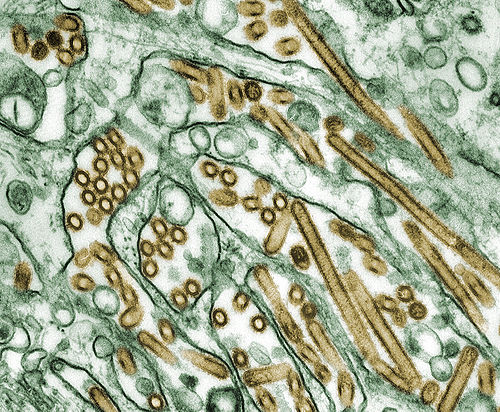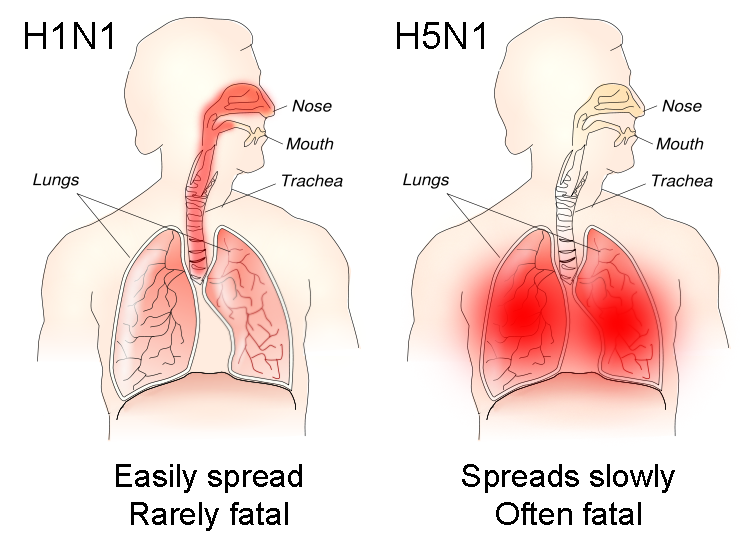Research on the H5N1 influenza (bird flu) virus’ human transmissibility is seriously starting to worry WHO (World Health Organization) experts – in a written statement, the authors express concern about the potential risks linked to this research. The possible negative consequences of some experiments are serious and potentially dangerous. However, WHO adds that in cases where scientists work under the strictest of conditions, experiments should continue so that the fight against bird flu may progress.
The H5N1 flu virus does not infect humans easily or often. However, it currently kills 60% of those it does infect. Experts fear that bird flu viruses might eventually genetically adapt so that they spread easily from human-to-human, resulting in a devastating flu pandemic.
Bird flu is also known as avian flu.
It is crucial that research which aims to better understand these viruses and can eventually minimize the risk to public health be allowed to continue, WHO emphasizes. Gains in scientific knowledge and public health benefits can only occur effectively if countries which are carrying out such research share their viruses, as well as their findings.
Put simply, in order to get the best benefits for humankind, countries should share:
- The viruses they have
- The results (findings) of their research
Scientific advancement must be done responsibly. Research that generates more virulent (potent) forms of the virus is risky. Such research should only be pursued when it has been shown clearly that the potential benefits compellingly outweigh the risks. Experiments need to be conducted under the strictest of controls.
The PIP (Pandemic Influenza Preparedness) Framework came into effect in May 2011. All WHO member states adopted the Framework. It is a guide, which shows participants how to share influenza viruses with the potential for pandemics, plus the benefits which may be derived from such research.
The Framework stipulates that influenza viruses with pandemic potential should be shared through WHO’s GISRS (Global Influenza Surveillance and Response System). Through the Framework, members should “..collaborate with, and appropriately acknowledge, scientists in countries where the virus originated when initiating research.”
In a written communiqué, WHO stated:
“WHO recognizes that the scientists who led the work of the new studies received their virus samples from the WHO Global Influenza Surveillance Network (GISN), which preceded GISRS, and before negotiations on the new PIP Framework began. However, now that the Framework has been adopted by all WHO Member States, WHO considers it critically important that scientists who undertake research with influenza viruses with pandemic potential samples fully abide by the new requirements.
Since the PIP Framework represents a major step forward and was agreed upon only after several years of difficult negotiations, WHO stresses that this H5N1 research must not undermine this major public health achievement. WHO will work with Member States and other key parties to ensure scientists understand the new requirements that have been agreed to with the Framework.”
The USA has already called for censorship on work carried out in America and The Netherlands. They are concerned that publishing those findings could provide bio-terrorists with the possible means to cause devastation.
Two journals are planning to publish their work (done in the US and Dutch laboratories). The US National Science Advisory Board for Biosecurity has asked the journals to publish redacted versions of the latest studies. Leading scientists, as well as the editors of the journals, are not happy with this request.

Influenza A virus, known as A(H5N1), a subtype of H5N1 (bird flu) virus
There are several possible ways. If a person with normal human flu (H1N1) also becomes infected with a bird flu virus (H5N1), the bird flu virus could exchange genetic material with the normal flu one. If it acquired the genes in the normal flu virus that make it highly human transmissible, the bird flu virus could, in theory, then spread rapidly from human-to-human. If this occurred, and approximately 60% of patients died (currently the case with humans infected with bird flu), and the spread was not stopped, the consequences could be devastating for humans worldwide.
At the moment, the H5N1 viruses infect humans deep down in respiratory system. This means that infected people’s coughs and sneezes contain very small amounts of the virus. If it started to infected higher up in the respiratory system, it would spread more easily.
Written by Christian Nordqvist
